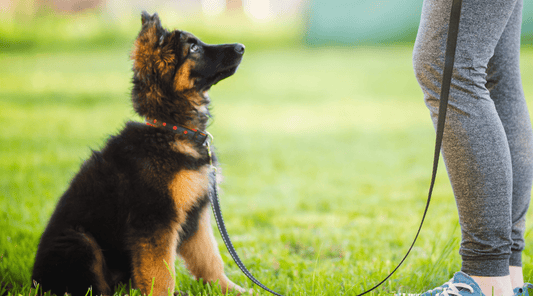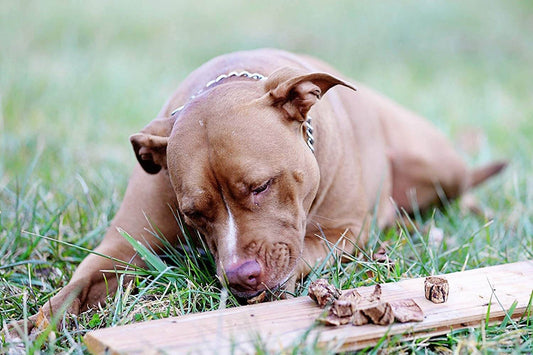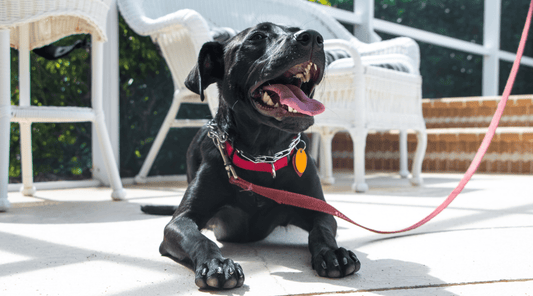How to Teach a Dog to Swim: A Splashy Day in Our Neighborhood
Dawn Miller May 15, 20254 Minute ReadA while back, I discovered my lab mix Bruno is part otter. One minute, we were taking an off-leash stroll next to the neighborhood pond. And the next, he's belly flopping into the cool water like he's preparing for the Summer Olympics.
Pixie, my mid-sized terrier, looked horrified, as if to say, what's wrong with him?
But I knew exactly what had gotten into him. As the days were getting warmer, he had water sports on his mind like everyone else. Dogs love to swim. And learning how to teach a dog to swim safely is one of the most rewarding things you can do for both of you.
Why You Have to Teach a Dog to Swim
Isn't swimming the most natural thing in the world for a dog? Turns out it's not.
Not every dog takes to water like Bruno. Just like when you teach your human children, there are risks that they won't get at first.
But with a bit of patience and some high-value dog treats, you can teach a dog to swim and quickly find out they love it.
Why Swimming Is a Great Skill for Dogs
Despite my opening, swimming isn't just for hot days and people with backyard pools. It's for everyone and has some fantastic health and wellness benefits. It's:
- Joint-friendly exercise (especially for older dogs or large breeds). When introduced safely, you may even notice improved mobility in dogs with arthritis.
- Burning energy in short bursts. It's great cardio, so it's a heart-healthy activity without putting excessive weight on the joints.
- Confidence-building. When dogs learn to master new skills, they strengthen their self-image, which can also improve mental health in distractible, anxious, or overreactive dogs.
- Overall dog health. Everything from brain health to circulation to muscle tone benefits from a good swim.
- Dog water safety. When you know your dog can swim, you feel more comfortable taking them fishing, boating, and canoeing. Larger dogs have even been known to save the lives of drowning children.
Bonus: Teaching your dog to swim can open up a whole new world of bonding games you can play, like water fetch or dog paddleboarding, surfing, or waterskiing (depending on where you are).
How to Teach a Dog to Swim
1. Start on Dry Land (Yes, Really)
Before we ever dipped a paw, I introduced the idea of water with play. We practiced commands like “stay” and “come” with the hose on and sprinklers spinning, and even a shallow kiddie pool.
So, I'd stand in the kiddie pool and say, "Bruno, come," inviting him into the pool with me. Then I'd get out and ask for a "stay." I'm always ready to give them a high-value treat when they obey.
This ensures dogs have a positive association with water. It can also reduce the panic that can happen when you suddenly realize your feet aren't on the ground.
And not just with any treat. I use beef lung bites—high-value and crunchy without being crumbly. Basically, crack for dogs (the legal, healthy kind). They're just single-ingredient beef organ meat.
2. Use a Dog Life Jacket for Safety and Confidence
Even if your dog’s part lab, a dog life jacket is essential for safety.
Make sure it fits snugly but comfortably and allows for full movement. A proper fit prevents slipping off but won't restrict paddling. Look for one with a handle on top (you’ll need it). Let your pup wear it around the house first so it feels familiar and comforting, like a warm hug. This one on Amazon is a great choice.
Bruno strutted around like a dock worker in his new yellow dog life preserver. But Pixie gave me side-eye until I traded the vest for a meaty dog bone stuffed with frozen pumpkin.
After that, she was onboard.
3. Start in Shallow, Calm Water
Before I took my dogs to the lake on the edge of town, we started in a pond where they could touch the ground. And yes, it was muddy.
If your kiddie pool (or, in my case, a dog swimming pool) is deep enough or your dog small enough, you stay a little cleaner than we did.
For larger dogs, the shallow end of a pool may be okay. But keep in mind their feet may not touch the ground.
Let your dog wade in at their own pace. Don’t toss them in. That’s how trust gets flushed.
I waded in with Pixie and tossed a floating toy just out of reach. When she paddled toward it? I marked the behavior with a happy "yes!" and gave her a treat on shore.
One paw at a time. That’s the rule.
4. Praise, Treat, Repeat
After every brave moment—a step deeper, a swim stroke, a fetch from the water—Pixie got a verbal reward. Because eating and swimming don't mix, I use a marker like a cheerful yes or a clicker.
If you’re using real dog bones after water play, look for something safe and natural.
We rotate in grass-fed marrow bones and beef trachea treats for a longer chew session that keeps the calm going.
These bones support not only post-swim chill time but also dog health with added nutrients and natural collagen for post-workout recovery.
5. Watch for Fatigue and Fear
Swimming is tiring, even for a dog who seems to have boundless energy on land like Pixie.
Honor their need for rest if you see signs your dog is done, such as:
- Heavy panting
- Ears back
- Trying to leave the water
- Climbing on you like you’re a flotation device
Celebrate their effort when you get out of the water. Build positive memories so they want to do it again.
Then let 'em dry off in the sun with a victory chew. I give 'em beef knee cap bones because you better believe we're going to celebrate like they just won the triple crown even if they spent 1 minute in the water.
Dog Water Safety Tips
Show your dog where the steps are. Rinse off chlorine after pool swims and hose down lake or pond water to remove algae, bacteria, or sediment that may irritate the skin, dull their coat, or cause infection. Never leave them unattended near water.
The bottom line is that teaching your dog to swim is less about laps and more about trust. Build positive associations with treats and happy memories by getting out there and bonding with your dog.
And if your pup is still working on their training basics, the 7-Day Dog Training Challenge is a great place to dive in.
Available On:
Disclosure: This article may contain affiliate links, which means we may earn a small commission if you make a purchase through these links—at no extra cost to you. We only recommend products we trust and believe will benefit you and your K9.






